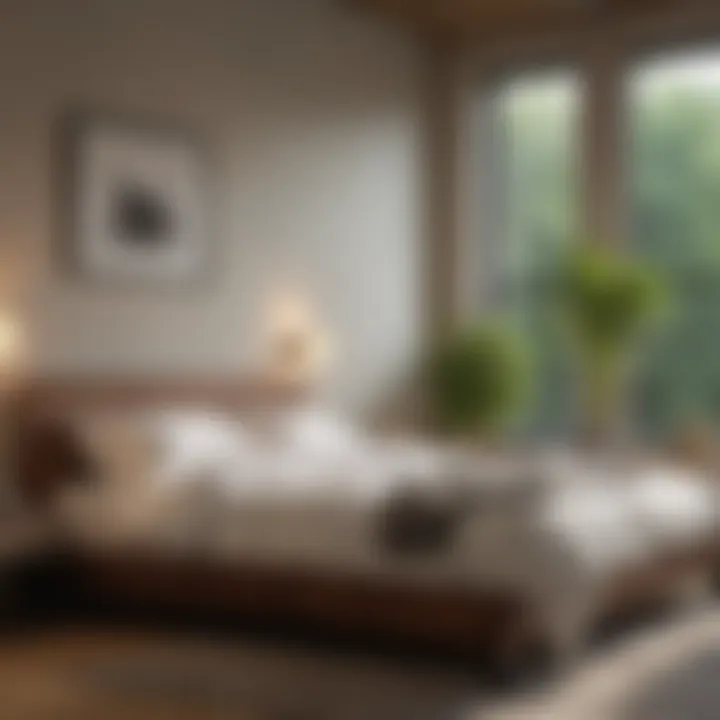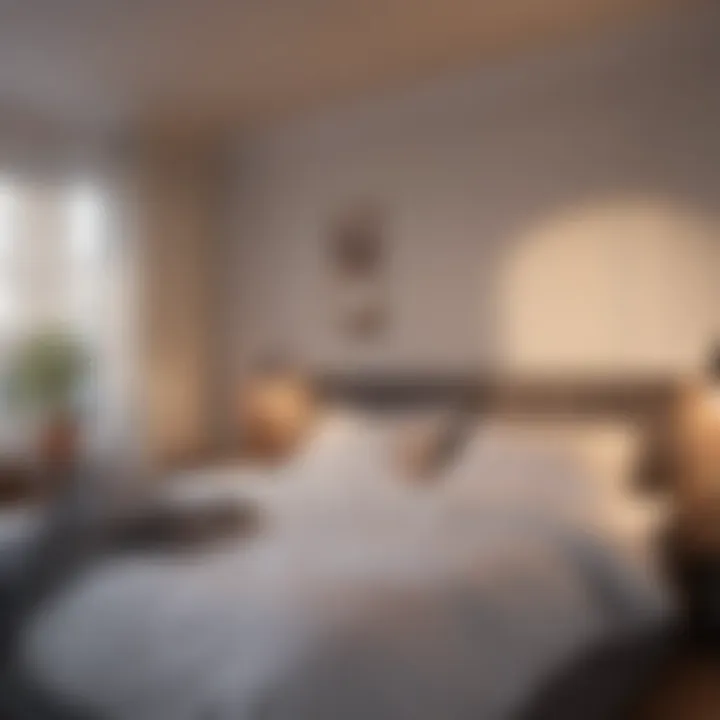Optimal Bed Orientation: Enhance Sleep and Design


Intro
The orientation of your bed in a bedroom is a often overlooked but significant factor that can greatly influence various aspects of your life. Bed placement has implications on sleep quality, aesthetics, and even your daily mood. Homeowners, interior design enthusiasts, and anyone invested in creating a nurturing sleeping environment can benefit from understanding the nuances behind optimal bed orientation.
While some people instinctively know where to position their bed, others may require guidance on how to make the best choices. This article aims to unravel the intricacies of bed placement by considering cultural beliefs, scientific research, and design principles. Throughout this exploration, readers will gain valuable insights that can lead to an enhanced bedroom atmosphere conducive to restful sleep.
As we move forward, we will examine practical tips, trend insights, and essential aspects of creating a well-thought-out sleeping space.
Interior Design Tips
When contemplating bed orientation, several interior design principles come into play. Taking a thoughtful approach can not only enhance the functionality of the space but also contribute to a more inviting aesthetic.
Trendy Design Ideas
Current trends in interior design lean toward maximizing natural light and creating serene spaces. To achieve this, consider orienting your bed towards windows to benefit from daylight, particularly in the morning. This can help you wake up feeling refreshed. Conversely, if your bedroom faces heavy traffic or loud streets, positioning your bed away from the window can help create a more peaceful sleeping environment.
Color Schemes and Combinations
Color plays a crucial role in setting the mood of a bedroom. Choosing calming colors like soft blues or gentle greens can promote relaxation. When deciding on bed orientation, keep in mind that the color scheme should harmonize with the bed’s position. For example, a bed placed against a feature wall painted in a darker hue can create a striking balance, enhancing the visual appeal of the room.
Furniture Arrangement Techniques
A well-planned furniture arrangement fosters a smooth flow of movement in any room. It is important to leave sufficient space around the bed for easy access and to avoid a cluttered environment. Additionally, consider incorporating bedside tables or lamps on both sides to create symmetry, which can greatly enhance the room's overall appeal.
"The way you arrange your furniture can dictate how you interact within the space, improving both functionality and aesthetics."
Prolusion to Bed Orientation
Understanding the concept of bed orientation is essential for optimizing not just the aesthetics of a bedroom, but also its functional aspects. Bed orientation refers to the positioning of the bed within a room and how that placement interacts with various elements such as light, airflow, and even cultural beliefs. This article aims to delve into the nuances of bed orientation, providing homeowners and design enthusiasts with valuable insights.
The importance of proper bed orientation lies in multiple areas. Firstly, it plays a significant role in sleep quality. Research indicates that the direction in which one sleeps can have a measurable effect on sleep cycles and restfulness. Poor placement may lead to disturbed sleep or feelings of discomfort, impacting the overall well-being.
Additionally, bed orientation has a direct influence on the aesthetic appeal of a bedroom. A well-placed bed can enhance the visual flow and symmetry of a room, creating a harmonious environment. When considering decor and furniture layout, the bed often serves as the focal point. Thus, its orientation can dictate the entire room's atmosphere.
Moreover, there are cultural perspectives that shape how individuals view bed placement. For instance, Feng Shui emphasizes specific orientations to optimize energy flow, while Western traditions often have different but equally valid methods of arranging a bedroom. Understanding these cultural nuances further enriches the conversation around optimal bed placement.
Cultural Perspectives on Bed Placement
Understanding cultural perspectives on bed placement illuminates how various beliefs and traditions influence the way we arrange one of the most crucial fixtures in our homes. Bed orientation does not only affect physical comfort or aesthetics; it intertwines deeply with social norms, spirituality, and psychological well-being. Considering these factors can enhance restfulness and contribute to creating a harmonious atmosphere in the bedroom.
Different cultures exhibit unique values and rituals connected to sleep. Embracing an awareness of these perspectives can foster intentional design choices that resonate with individual or shared values, optimizing one's sleeping environment while respecting historical wisdom.
Feng Shui Principles
Feng Shui, an ancient Chinese practice, emphasizes the balance of energy within a space. It is believed that the orientation of furniture, including the bed, can influence the flow of Qi (or life energy), affecting health, relationships, and prosperity.
In Feng Shui, it is commonly advised that beds should be placed against a solid wall, away from the door but within sight of it. This position is thought to provide a sense of security and control, promoting better sleep. The headboard acts as a stabilizing force for energy, merging psychological comfort with physical safety. Moreover, avoiding positioning the bed directly in line with the door, known as the "coffin position," is crucial as this is seen as potentially detrimental.
Incorporating Feng Shui principles presents homeowners with a holistic perspective that goes beyond traditional aesthetics, allowing for the creation of a sanctuary that nurtures wellbeing psychologically and physiologically.
Western Traditions
Western traditions regarding bed placement often revolve around practicality and personal preference, though this approach is also influenced by historical context. For instance, in many homes, the bed's placement often depends on architectural layouts, such as the alignment with windows or the structure of the room.
Traditionally, placing a bed against the longest wall of a room provides a sense of symmetry and balance. Western cultural norms may prioritize functionality, considering factors like natural light, temperature, and access to electrical outlets when arranging a bedroom. This prioritization often results in a more utilitarian approach, focusing on maximizing space while ensuring comfort through choice of materials and design.
Global Variations
Households globally exhibit varied orientations based on distinct cultural beliefs. In some Latin American cultures, for example, it's common to place the bed in a corner to optimize space and allow for familial closeness. In contrast, in Scandinavian countries, the focus is often on maximizing natural light. Here, beds positioned near windows are preferred to enhance the experience of seasonal light changes.
Middle Eastern homes may place an emphasis on privacy, leading to bed placements that ensure full coverage from views while still allowing ample airflow through the windows.
These cultural variations offer rich insights into how deeply bed orientation can affect both personal comfort and broader social interactions. They remind us that the way we arrange our sleeping spaces is a manifestation of cultural identity, personal beliefs, and communal values.
Scientific Insights on Sleep Quality
Understanding the scientific insights into sleep quality provides homeowners with valuable knowledge about how bed orientation can influence one’s ability to achieve restful sleep. Sleep is an essential component of human health, impacting everything from cognitive function to immune response. In this context, the position of your bed is not just a matter of aesthetic preference; it can actually affect the quality of sleep you experience. Several key factors come into play here.
Impact of Orientation on Sleep Cycles
Research suggests that bed orientation can affect sleep cycles. Different orientations might influence the comfort and quality of sleep. Initially, it is essential to recognize the natural sleep cycles, which include REM and non-REM stages. These stages are crucial for restorative sleep, and disturbances can affect overall sleep quality.


Some studies indicate that a north-south orientation may align better with the Earth’s magnetic field. This alignment can potentially reduce disturbances during sleep. Homeowners should consider the layout of their bedrooms in relation to natural light sources and noise, as these factors can also play a significant role in how our beds are oriented. A well-planned orientation can foster deeper sleep and a better recovery process overnight.
Additionally, the comfort of the mattress and the overall setup contributes significantly to sleep quality. Adjustable bases and other ergonomic considerations can enhance sleep cycles. The right position of the bed can also help in soothing anxiety and promoting relaxation.
Magnetic Fields and Sleep
The influence of magnetic fields on sleep is a fascinating area of study. While research is still ongoing, some scientists propose that certain orientations can minimize exposure to artificial electromagnetic fields (EMF) that can disrupt sleep patterns. For instance, excessive exposure to EMF from devices, such as smartphones and routers, may result in poorer sleep quality.
To address this, homeowners might consider situating their beds away from electronic devices and wiring. Some experts suggest north-south bed orientations as a way to mitigate these effects, arguing this position can lead to a more peaceful sleep experience. It’s crucial to assess the surrounding environment because a calm room can support better sleep hygiene.
"Creating a restful environment in your bedroom plays a pivotal role in enhancing sleep quality. Orientation matters more than one might initially assume."
In sum, examining the scientific aspects of sleep quality reveals how bed orientation is more than just a design choice. Homeowners and interior design enthusiasts should pay close attention to these insights, ensuring their sleep environments are optimized for better health and wellness.
Psychological Factors in Bed Orientation
Understanding psychological factors in bed orientation is essential for creating a harmonious sleeping environment. The way in which a bed is positioned affects not just aesthetics but also emotional well-being and individual comfort. A well-thought-out layout can foster a sense of security and tranquility—a key component for restorative sleep.
Perception of Space
The perception of space in a bedroom plays a significant role in how one feels in their surroundings. Bed orientation influences the way we interact with that space. A bed facing a door may create a feeling of vulnerability, whereas a bed positioned in a corner can provide a sense of safety and enclosure, leading to better relaxation.
Factors influencing perception of space include:
- Room Size: A small room may feel cramped if the bed is not appropriately placed. A bed positioned along the longest wall can elongate the room’s appearance.
- Ceiling Height: Taller ceilings can make a room feel airier if the bed is oriented towards them, while low ceilings can make furnishings feel oppressive.
- Focal Points: The direction in which a bed faces can draw attention to specific features, such as windows or artwork. This focus can change the feel of the room dramatically.
"The arrangement of furnishings can either enhance or diminish one's sense of comfort and space."
Additionally, how individuals visualize a space is influenced by their past experiences and cultural backgrounds. Some may prefer an open layout, while others feel more comfortable in a cozier, enclosed configuration.
This aspect also ties closely with personal preferences. Homeowners should consider how different orientations make them feel. Being conscious of one's emotional responses to bed placement may aid in choosing an orientation that promotes deeper relaxation.
Ultimately, psychological considerations in bed orientation are not merely about position but are about how one connects with their living space. While practical elements like room dimensions are important, the emotional tranquility and comfort that come from a well-considered layout can significantly enhance the quality of life.
Aesthetic Considerations in Bedroom Layout
When thinking about the arrangement of your bedroom, the aesthetic factors are key. They go beyond just how things look, deeply affecting the mood and function of the space. An organized and visually pleasing layout creates comfort and tranquility. In this section, we will discuss critical elements, benefits, and considerations regarding aesthetic choices in bedroom layouts as related to bed orientation.
Choosing the correct bed placement can greatly influence the overall feel of the room. These decisions is not merely about personal preference; it reflects how a room functions in daily life. A well-placed bed can enhance natural light and facilitate movement within the space. From color schemes to spatial relationships, several aspects contribute to a harmonious bedroom environment.
Symmetry and Balance
Symmetry in a bedroom promotes a sense of stability and calm. Placing the bed centrally along the longest wall can create a focal point. This symmetry can be enhanced by arranging matching bedside tables and lamps on either side.
- Visual appeal: Symmetrical arrangements are generally pleasing to the eye, making the room feel orderly.
- Improved functionality: With balanced placements of furniture, access to essential items like lamps or books is made easier.
- Enhanced relaxation: A room that is visually balanced can also feel more relaxing, which is vital in a space intended for sleep.
Balance can be further achieved by incorporating decorative elements to the arrangement. For instance, using artwork that mirrors the bedroom’s furnishings can solidify this balance.
"A balanced room layout not only looks good but also enhances the overall experience of the space."
Natural Light Flow
Natural light should be a prime consideration in any bedroom layout, influencing the orientation of the bed. Placing the bed near windows allows occupants to wake up to daylight, which can foster a more energizing atmosphere. Here are several points that detail the importance of natural light flow:
- Mood enhancement: Natural light helps regulate circadian rhythms, promoting better sleep and waking cycles.
- Aid in decor: Light coming from windows can highlight design choices like wall colors, textures, and art, enhancing the aesthetic.
- Energy efficiency: Maximizing light can reduce the need for artificial lighting during the day, making the space feel more open and airy.
Deciding on bed placement with natural light in mind can transform not only the aesthetics but also the overall experience of the bedroom. Adjustments can be made based on window sizes and orientations relative to the bed for the best effect.
Practical Tips for Choosing Bed Orientation
Choosing the right orientation for your bed is a crucial step toward optimizing your sleeping environment. The way your bed is placed can influence not only your comfort but also the overall aesthetic and functionality of your bedroom. Understanding practical tips can help you make informed decisions that enhance restfulness and appeal.
Assessing Room Dimensions
Before placing a bed, it is essential to evaluate the dimensions of the room. Each square foot of space offers unique possibilities. Measure the length and width of your bedroom to determine if your bed can fit comfortably without obstructing pathways or furniture.
Additionally, note the placement of windows and doors. A bed positioned away from direct light may aid in better sleep, while a layout that avoids blockages enhances flow in the space. Use common guidelines such as leaving about two feet of space around the bed for ease of movement.
A concise list of considerations includes:
- Room Size: Larger rooms can accommodate larger beds without feeling cramped.
- Shape: Rectangular rooms may allow for different orientations compared to square spaces.
- Access Points: Ensure your bed does not hinder access to doors and windows.
Understanding Personal Preferences


Personal preferences play a significant role in deciding bed orientation. Each individual has unique needs based on their lifestyle and sleeping habits. This section emphasizes key factors to consider:
- Sleep Style: If you are a restless sleeper, ensuring enough space to move freely is vital. You may opt for orientation that aligns with your body's natural movements during sleep.
- Aesthetics: Some homeowners may prefer a focal point in the room, such as the bed, to enhance visual appeal. Think about what appeals to you when you enter your bedroom.
- Compatibility with Accessories: Consider how bedside tables, lamps, and other accessories will fit around your bed. An organized and aesthetically pleasing arrangement contributes to a calming atmosphere.
As you contemplate these points, it's advisable to visualize placements before making any decisions. You might even experiment by temporarily rearranging furniture to gauge your comfort level.
"Creating a bedroom that feels right is about balancing function with personal expression."
By taking room dimensions and personal preferences into account, you can confidently choose an orientation that suits your lifestyle, thereby optimizing your bedroom for relaxation and comfort.
Common Bed Orientation Practices
Understanding bed orientation is crucial for several reasons. Ideal bed placement can influence sleep quality, aesthetic appeal, and how one feels in a bedroom space. When homeowners consider common practices, they draw on traditional, cultural, and practical insights that guide their decisions. Knowing the foundational orientations provides a roadmap to achieving both comfort and style in bedroom design.
North-South Orientation
The north-south bed orientation is often cited as optimal from various perspectives. One significant aspect relates to magnetic fields and how they interact with the human body. Many individuals believe that sleeping with the head oriented in the north can promote a peaceful night's rest, reducing stress and improving overall sleep cycles.
Furthermore, positioning the bed this way can enhance the natural flow of energy in a room, aligning with concepts from practices like Feng Shui. In terms of practicality, this orientation often accommodates better access to light and views from windows, allowing for a more inviting atmosphere.
Benefits of this orientation include:
- Enhanced Sleep Quality: Aligning the body with the Earth's magnetic field may promote better restfulness.
- Light Optimization: This layout often allows morning sunlight to flow into the room, boosting mood when waking up.
East-West Orientation
Alternatively, the east-west orientation has its supporters, especially based on the idea of how daylight influences wake patterns. By placing the head of the bed toward the east, homeowners may leverage the benefits of sunrise. This practice often allows individuals to wake more naturally with the light, promoting alertness and a refreshed feeling upon rising.
This orientation can be particularly beneficial for those who have struggles with sleep inertia, a feeling of grogginess upon waking. Moreover, placing the bed this way may offer a visually balanced room, accommodating evening lighting elements without overwhelming the space.
Some considerations for this orientation are:
- Natural Awakening: Waking with the sun can lead to a more alert and refreshing start to the day.
- Visual Balance: When designed thoughtfully, this layout can create appealing symmetry, enhancing the bedroom's overall aesthetic.
Technology in Bed Orientation
In the modern era, technology plays a pivotal role in various aspects of our lives, including how we design and utilize our sleeping spaces. The inclusion of advanced technology in bed orientation not only enhances comfort but also facilitates a deeper understanding of how environmental variables affect sleep quality. Homeowners and design enthusiasts alike can benefit from integrating smart technology with traditional design principles. Such combinations allow for customizable environments that respond to individual preferences and needs.
Smart Beds and Sleep Tracking
Smart beds are becoming increasingly popular due to their ability to adapt to the sleeper's body and personal requirements. These beds often come equipped with a variety of features designed to promote better sleep quality. Here are some critical aspects of smart beds and the benefits they offer:
- Automatic Adjustments: Many smart beds can adjust firmness based on the sleeper's weight and sleep position. This customization can lead to improved comfort and support, ultimately enhancing overall sleep quality.
- Sleep Tracking Technology: Most smart beds have built-in sensors that monitor sleep patterns. By tracking factors such as heart rate, breathing, and movement, these beds provide valuable data. Homeowners can use this information to understand their sleeping habits and make necessary adjustments.
- Integrated Climate Control: Some models offer temperature controls, allowing users to set their preferred sleeping temperature. This feature can further enhance comfort, particularly for those who tend to sleep hot or cold.
- Data Visualization and Analysis: Many smart beds provide insights through companion apps. These interfaces help users visualize their sleep data and establish trends over time. Analyzing this data can lead to informed decisions about bedroom orientation and layout.
"The integration of smart technology into sleeping arrangements has revolutionized how individuals interact with their sleeping environments, paving the way for an enhanced, restorative experience."
Influence of Personal Circumstances
The orientation of a bed often reflects more than mere aesthetics. It embodies the complexities of personal circumstances that vary widely among individuals and families. Understanding how these personal variables affect bed orientation decisions is crucial. Factors such as shared living situations, family dynamics, and individual lifestyles can significantly impact the chosen placement of a bed. In this section, we will delve into how these elements come into play and why they matter in creating an ideal sleeping environment.
Roommates and Shared Spaces
When living with roommates, the shared nature of the space introduces unique considerations for bed orientation. Roommates may have different schedules, preferences, and routines that could influence sleep patterns. For instance, someone who works night shifts may prefer the bed to face away from common areas to minimize disturbances from others during their rest. Additionally, space constraints may necessitate a creative approach to bed placement.
It is important for roommates to communicate. Open discussions can lead to a consensus about bed orientation that minimizes conflicts and accommodates everyone's needs. Consideration of personal space and privacy also plays a role. A well-placed bed can enhance feelings of security and serenity, important elements in a shared environment.
Some strategies for optimizing bed orientation in shared spaces include:
- Utilizing partitions or screens: These can provide physical barriers that enhance privacy while allowing personal preferences for bed orientation.
- Creating a unified aesthetic: Selecting a coordinated bedding scheme that resonates with everyone can create a cohesive look, making the room feel more harmonious.
- Capitalizing on layout: Consider how furniture placement can help distribute noise levels and light. For example, orienting the bed away from windows might shield from street noise or early morning sun.
Family Dynamics
Family structures often dictate specific requirements for bed orientation. Parents may need to consider the placement of a bed in relation to children's rooms. Proximity to a child’s space can influence how attentive parents can be during nighttime waking. Additionally, the age of a child could bring about different considerations. Toddlers might need beds placed where parents can quickly respond to their needs, while teenagers might prefer the autonomy of distance.
Furthermore, a family’s dynamic may shift over time, requiring a re-evaluation of bed placement. As children grow, their preferences and independence will evolve. Engaging family members in discussions about bed orientation fosters a sense of ownership over the space.
Some practical considerations regarding family dynamics include:
- Flexibility: Adapting the room layout based on changing family needs. This may include moving beds as kids transition from sharing a room to needing a more personal space.
- Safety: For young children, ensure that beds are away from windows or any potential hazards, impacting how far the bed can be pushed against walls.
- Accessibility: Consider the ease of movement in the room, especially when many family members might be moving throughout the day.
"Understanding one's living situation is essential to achieving optimal bed orientation. Thoughtful discussions can lead to a more peaceful and restful environment."


The Role of Accessories and Decor
Accessories and decor play a significant role in shaping the overall ambiance of a bedroom. They serve not only as embellishments but also as functional elements that enhance both aesthetic appeal and comfort. Understanding how to optimize the use of accessories is crucial for homeowners aiming to create a serene sleeping environment.
In addition to the primary furniture, such as the bed, the selection and arrangement of accessories can influence perception of space, light, and even emotional comfort. As such, the thoughtful choice of decor is vital. Accessories can help in balancing or highlighting the bed orientation you’ve chosen. Using appropriate items can help define the space, contributing to an atmosphere that promotes either relaxation or stimulation, based on your needs.
Bedside Tables and Lamps
Bedside tables are more than simple surfaces. They offer convenience to access items like books, glasses, or a glass of water. Ideally, the bedside table should be so high that it aligns with the top of the mattress. This makes reaching for items easy during the night without requiring much effort or motion.
Lamps provide necessary light for reading or other activities before sleep. The placement of lamps can also affect the overall feel of the room. Soft, warm light encourages relaxation, while brighter lights may keep one alert. Choosing lamps with adjustable brightness can add flexibility, aligning with individual bedtime routines.
"The right bedside table and lamp combination can not only enhance function but also provide a sense of style and cohesion in the bedroom."
When selecting these items, consider the style of your room. A minimalist design might benefit from sleek, modern tables and lamps. In contrast, a more traditional space could utilize ornate designs or antique finishes. Ultimately, it is essential to choose items that support the main purpose of your bedroom: rest.
Wall Art and Textiles
Wall art and textiles add personality and warmth to the bedroom. They can reflect one’s tastes and establish a certain mood. Wall art, such as paintings or photographs, may serve as a focal point that draws the eye. However, it must be hung at an appropriate height to avoid straining your neck when viewing.
Textiles, including curtains, bedspreads, or throw pillows, add layers of comfort. The colors and patterns of these fabrics can also significantly impact mood and ambiance. Calming colors, such as blues or soft greens, promote relaxation. On the other hand, vibrant hues can energize a space, making it feel lively and inviting.
In addition, consider the material of textiles. Natural fibers, like cotton or linen, often breathe better, enhancing comfort during sleep. Ensuring that textiles tie in harmoniously with the overall décor theme enhances visual coherence.
Optimal bed orientation can be further enhanced by well-placed accessories and decor. Through thoughtful consideration of elements like bedside tables, lamps, wall art, and textiles, homeowners can significantly elevate their sleeping spaces, making them not just functional, but beautiful sanctuaries.
Case Studies: Successful Bed Orientations
In exploring optimal bed orientation, it is essential to examine real-world examples that demonstrate the effectiveness of various placements. Case studies provide a robust framework for understanding how bed orientation can enhance sleep quality and room aesthetics. These examples show practical applications, illustrating how thoughtful decisions can lead to improved living conditions.
The importance of such case studies lies not just in their variety but also in the valuable insights they offer. Each situation reveals different aspects of bed placement, demonstrating how various factors—room size, window placement, and personal preferences—all play a role in determining the best orientation. Through these examples, one can get a clearer picture of how to approach their sleeping environment with intention and purpose.
Additionally, the benefits of studying successful bed orientations include:
- Understanding context-specific solutions: Different homes have unique layouts, which means that the same rules may not always apply. Case studies help highlight successful adaptations in various settings.
- Learning from others' experiences: Homeowners can benefit from the successes and challenges faced by others, allowing them to make informed decisions without starting from scratch.
- Inspiration for creativity: Seeing how others have arranged their spaces can inspire new ideas and innovative solutions for optimizing one’s own bedroom.
Residential Examples
When analyzing residential examples of successful bed orientations, several key instances stand out. Each provides insight into the diverse factors that influence the positioning of a bed within a room.
- Small Apartment Living: In a compact urban apartment, one homeowner positioned their bed along the north wall, away from the main entrance and windows. They reported improved sleep quality due to reduced disturbances, creating a calming atmosphere. This layout allows more room for movement and furnishings, maximizing space efficiency.
- Open Concept Homes: In a modern open-concept house, a couple decided to orient their bed to face the view of their garden. By doing this, they brought in natural light, enhancing their morning routine while connecting them with nature. This example illustrates how aesthetic and psychological factors intertwine in bed placement.
- Family Dynamics: In a family home with children, the parents placed their bed against a wall with a strategic view of the entrance and children's rooms. This arrangement allows for better visibility and a sense of security, enabling restful sleep knowing they can easily observe the entire space.
- Cultural Influences: One family, adhering to traditional Feng Shui principles, oriented their bed in the auspicious direction according to their birth elements. The family noted an increase in tranquility and harmony within their home, reflecting the power of cultural traditions in influencing bedroom design.
Each of these examples serves as a valuable resource for homeowners and designers alike. They showcase not only successful tactics but also the importance of considering individual needs and room dynamics when choosing bed orientation. Through these case studies, the concept of optimal bed orientation evolves, emphasizing personal comfort, functionality, and aesthetics.
Addressing Common Misconceptions
In the exploration of bed orientation, it’s essential to clarify prevalent misconceptions surrounding this subject. Misunderstanding the impact of bed placement can lead to poor sleeping conditions, inefficient use of space, and suboptimal aesthetics in the bedroom. Addressing these misconceptions allows homeowners and interior design enthusiasts alike to cultivate a more thoughtful environment that enhances restfulness and overall quality of life.
Importance of Addressing Misconceptions
Often, individuals assume that simply placing a bed against any wall suffices. However, contrary to this belief, bed orientation holds significant influence over various aspects of life. It affects air circulation, room dynamics, and even the flow of energy, particularly in the context of practices like Feng Shui. When people overlook these factors, they may unknowingly create spaces that promote discomfort and disrupt tranquility.
By confronting these misconceptions, we can promote a deeper understanding that facilitates better decision-making. This understanding not only enhances sleep but also contributes to the bedroom's visual appeal and functionality. Homeowners can further benefit from a comprehensive approach to their spaces, encouraging personal enjoyment and overall well-being.
Debunking Myths about Sleep
There are several myths surrounding sleep, and among these, the role of bed orientation often gets misrepresented. It’s essential to delineate reality from fiction regarding how bed placement affects sleep quality.
One common myth is that bed orientation does not matter. Some people believe it’s merely a personal preference. In reality, positioning a bed too close to a window, for example, can expose individuals to disruptions from external light and noise. Furthermore, placing a bed in a corner can create feelings of claustrophobia, resulting in heightened anxiety during rest.
Another prevalent myth is that all orientations are equal in promoting restful sleep. In fact, scientific studies suggest a subtle preference for north-south orientation in some individuals, which may align human biological rhythms with the Earth's magnetic field. The belief that personal preference trumps all other factors fails to take this aspect into consideration, potentially leading to strategic misplacement when setting up a bedroom.
This section emphasizes the importance of recognizing and debunking these unhelpful myths. By doing so, we empower readers with accurate information that can lead to better choices in their own homes. Addressing misunderstandings not only educates but also encourages more intentional design choices conducive to a restful sleep environment.
"Mistakes in bed orientation often result in more than just discomfort; they can ripple through the individual's overall well-being and experience at home."
In summary, understanding the truth behind bed orientation and sleep quality is vital. Doing so demolishes barriers to achieving an optimal sleeping environment where homeowners can flourish.
Epilogue: Finding Your Ideal Bed Orientation
In the pursuit of achieving an optimal sleep environment, the topic of bed orientation holds significant importance. This article has emphasized that the placement of a bed is not merely about aesthetics; rather, it interweaves various elements affecting sleep quality, cultural perceptions, and psychological comfort. Understanding the implications of bed orientation can empower homeowners to create spaces that promote restful sleep and harmonious living.
Several considerations emerge when determining your ideal bed orientation. Firstly, personal preferences play a crucial role. Every individual has unique sleeping habits and needs that should be taken into account. Some may prefer facing east to enjoy the morning sun, while others might find comfort in a more sheltered corner of the room. This leads to a conducive atmosphere tailored to personal taste.
From a scientific perspective, factors like sleep quality are undeniably influenced by the direction in which the bed is placed. Research indicates that certain orientations can affect how well a person sleeps due to magnetic fields and circadian rhythms. Hence, assessing these elements is vital in determining the best placement for maximizing comfort.
Moreover, aesthetic considerations cannot be overlooked. The design of a bedroom must feel cohesive and inviting. The way a bed is positioned can change the perception of space and contribute to the overall emotional ambiance of the room. A well-thought-out bed orientation aligns with principles of symmetry and natural light flow, enriching both functionality and allure.
"The direction in which a bed is oriented may subtly influence sleep, mood, and energy levels. Each element, from layout to lighting, plays a critical role in crafting the perfect sleep space."







